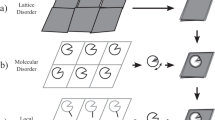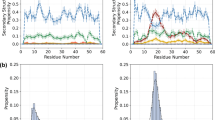Abstract
We present a protocol for predicting protein flexibility from NMR chemical shifts. The protocol consists of (i) ensuring that the chemical shift assignments are correctly referenced or, if not, performing a reference correction using information derived from the chemical shift index, (ii) calculating the random coil index (RCI), and (iii) predicting the expected root mean square fluctuations (RMSFs) and order parameters (S2) of the protein from the RCI. The key advantages of this protocol over existing methods for studying protein dynamics are that (i) it does not require prior knowledge of a protein's tertiary structure, (ii) it is not sensitive to the protein's overall tumbling and (iii) it does not require additional NMR measurements beyond the standard experiments for backbone assignments. When chemical shift assignments are available, protein flexibility parameters, such as S2 and RMSF, can be calculated within 1–2 h using a spreadsheet program.
This is a preview of subscription content, access via your institution
Access options
Subscribe to this journal
Receive 12 print issues and online access
$259.00 per year
only $21.58 per issue
Buy this article
- Purchase on Springer Link
- Instant access to full article PDF
Prices may be subject to local taxes which are calculated during checkout

Similar content being viewed by others
References
Carugo, O. & Argos, P. Reliability of atomic displacement parameters in protein crystal structures. Acta Crystallogr. D Biol. Crystallogr. 55, 473–478 (1999).
Petsko, G.A. & Ringe, D. Fluctuations in protein structure from X-ray diffraction. Annu. Rev. Biophys. Bioeng. 13, 331–371 (1984).
Hansson, T., Oostenbrink, C. & van Gunsteren, W. Molecular dynamics simulations. Curr. Opin. Struct. Biol. 12, 190–196 (2002).
Elofsson, A. & Nilsson, L. How consistent are molecular-dynamics simulations — comparing structure and dynamics in reduced and oxidized Escherichia coli thioredoxin. J. Mol. Biol. 233, 766–780 (1993).
Kay, L.E. Protein dynamics from NMR. Nat. Struct. Biol. 5 (Suppl.): 513–517 (1998).
Ishima, R. & Torchia, D.A. Protein dynamics from NMR. Nat. Struct. Biol. 7, 740–743 (2000).
Palmer, A.G. NMR probes of molecular dynamics: overview and comparison with other techniques. Annu. Rev. Biophys. Biomol. Struct. 30, 129–155 (2001).
Lacroix, E., Bruix, M., Lopez-Hernandez, E., Serrano, L. & Rico, M. Amide hydrogen exchange and internal dynamics in the chemotactic protein CheY from Escherichia coli. J. Mol. Biol. 271, 472–487 (1997).
Korzhnev, D.M., Orekhov, V.Y. & Arseniev, A.S. Model-free approach beyond the borders of its applicability. J. Magn. Reson. 127, 184–191 (1997).
Palmer, A.G., Kroenke, C.D. & Loria, J.P. Nuclear magnetic resonance methods for quantifying microsecond-to-millisecond motions in biological macromolecules. Methods Enzymol. 339, 204–238 (2001).
Fushman, D., Cahill, S. & Cowburn, D. The main-chain dynamics of the dynamin pleckstrin homology (PH) domain in solution — analysis of N-15 relaxation with monomer/dimer equilibration. J. Mol. Biol. 266, 173–194 (1997).
Berjanskii, M.V. & Wishart, D.S. A simple method to predict protein flexibility using secondary chemical shifts. J. Am. Chem. Soc. 127, 14970–14971 (2005).
Wishart, D.S., Sykes, B.D. & Richards, F.M. The chemical shift index: a fast and simple method for the assignment of protein secondary structure through NMR spectroscopy. Biochemistry 31, 1647–1651 (1992).
Wishart, D.S. & Sykes, B.D. The 13C chemical-shift index: a simple method for the identification of protein secondary structure using 13C chemical-shift data. J. Biomol. NMR 4, 171–180 (1994).
Lipari, G. & Szabo, A. Model-free approach to the interpretation of nuclear magnetic resonance relaxation in macromolecules. 1. Theory and range of validity. J. Am. Chem. Soc. 104, 4546–4559 (1982).
Clore, G.M. et al. Deviations from the simple two-parameter model-free approach to the interpretation of nitrogen-15 nuclear magnetic relaxation of proteins. J. Am. Chem. Soc. 112, 4989–4991 (1990).
Markley, J.L. et al. Recommendations for the presentation of NMR structures of proteins and nucleic acids. IUPAC–IUBMB–IUPAB inter-union task group on the standardization of data bases of protein and nucleic acid structures determined by NMR spectroscopy. J. Biomol. NMR 12, 1–23 (1998).
Wishart, D.S. et al. 1H, 13C and 15N chemical shift referencing in biomolecular NMR. J. Biomol. NMR 6, 135–140 (1995).
Zhang, H., Neal, S. & Wishart, D.S. RefDB: a database of uniformly referenced protein chemical shifts. J. Biomol. NMR 25, 173–195 (2003).
Schwarzinger, S., Kroon, G.J., Foss, T.R., Wright, P.E. & Dyson, H.J. Random coil chemical shifts in acidic 8 M urea: implementation of random coil shift data in NMRView. J. Biomol. NMR 18, 43–48 (2000).
Schwarzinger, S. et al. Sequence-dependent correction of random coil NMR chemical shifts. J. Am. Chem. Soc. 123, 2970–2978 (2001).
Wang, Y. & Jardetzky, O. Probability-based protein secondary structure identification using combined NMR chemical-shift data. Protein Sci. 11, 852–861 (2002).
Iwahara, J., Peterson, R.D. & Clubb, R.T. Compensating increases in protein backbone flexibility occur when the dead ringer AT-rich interaction domain (ARID) binds DNA: a nitrogen-15 relaxation study. Protein Sci. 14, 1140–1150 (2005).
Zhang, F. & Bruschweiler, R. Contact model for the prediction of NMR N-H order parameters in globular proteins. J. Am. Chem. Soc. 124, 12654–12655 (2002).
Acknowledgements
This work was supported by the Natural Sciences and Engineering Research Council, the National Research Council's National Institute for Nanotechnology and the Protein Engineering Network of Centers of Excellence.
Author information
Authors and Affiliations
Corresponding author
Ethics declarations
Competing interests
The authors declare no competing financial interests.
Supplementary information
Supplementary Table 1
Random coil reference chemical shifts. (DOC 56 kb)
Supplementary Table 2
Neighboring residue chemical shift (in ppm) corrections. (DOC 132 kb)
Supplementary Table 3
Averaged chemical shifts (ppm) observed in β-strands and α-helices. (DOC 79 kb)
Supplementary Table 4
Weighting coefficients for RCI calculations (equation 1) with different sets of chemical shifts. (DOC 147 kb)
Rights and permissions
About this article
Cite this article
Berjanskii, M., Wishart, D. NMR: prediction of protein flexibility. Nat Protoc 1, 683–688 (2006). https://doi.org/10.1038/nprot.2006.108
Published:
Issue Date:
DOI: https://doi.org/10.1038/nprot.2006.108
This article is cited by
-
Prediction of order parameters based on protein NMR structure ensemble and machine learning
Journal of Biomolecular NMR (2024)
-
In silico studies reveal structural deviations of mutant profilin-1 and interaction with riluzole and edaravone in amyotrophic lateral sclerosis
Scientific Reports (2021)
-
Intuitive, reproducible high-throughput molecular dynamics in Galaxy: a tutorial
Journal of Cheminformatics (2020)
-
Automated and optimally FRET-assisted structural modeling
Nature Communications (2020)
-
Local unfolding of the HSP27 monomer regulates chaperone activity
Nature Communications (2019)
Comments
By submitting a comment you agree to abide by our Terms and Community Guidelines. If you find something abusive or that does not comply with our terms or guidelines please flag it as inappropriate.



